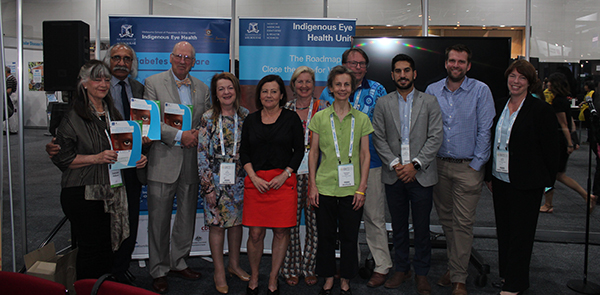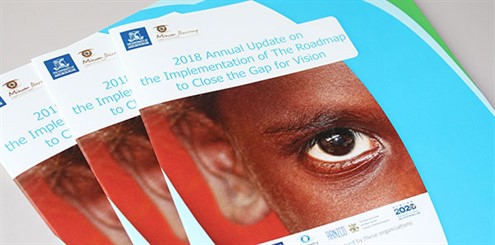1:30min

At Monday’s launch are, L-R, founding director of The Fred Hollows Foundation Gabi Hollows, community liaison officer, Department for Communities and Social Inclusion, Government of South Australia Trevor Buzzacott, University of Melbourne Harold Mitchell Professor of Indigenous Eye Health Professor Hugh Taylor, Optometry Australia CEO Lyn Brodie, and optometrists, principle project consultant, NSSS Project for Vision 2020 Australia and a member of the Optometry Australia Aboriginal and Torres Strait Islander Eye Health Advisory Group Lisa Penrose, Dr Gillian Cochrane from Deakin University, member of Optometry Australia’s Aboriginal and Torres Strait Islander Eye Health Advisory Group Dr Genevieve Napper, University of Melbourne Senior Research Fellow, Indigenous Eye Health, Mitchell Anjou, Jose Estevez from the South Australian Health and Medical Research Institute, Flinders University Associate Lecturer and a member of the Optometry Australia Aboriginal and Torres Strait Islander Eye Health Advisory Group Ben Hamlyn, and Vision 2020 Australia CEO Judith Abbott.
______________________________
By Helen Carter
Journalist
The gap in eye health between Indigenous and non-Indigenous Australians is on track to close within the next two years, the annual vision roadmap update has predicted.
Trachoma is also set to be eliminated from Australia by 2020.
The 2018 Annual Update on the Implementation of The Roadmap to Close the Gap for Vision released today highlighted that in 2008 the rate of blindness among Indigenous people was six times that of the national rate.
However, in 2016, it was found that the national rate had been reduced to three times that of non-Indigenous Australians and is on track to equal that of the non-Indigenous population by 2020.
The update shows the Roadmap is near to covering all of Australia with 53 of 63 regions nationwide working to coordinate eye care for Indigenous people, covering more than 70 per cent of the nation’s Indigenous population.
Rates of trachoma have also dropped from 21 per cent in outback children in 2008 to 3.8 per cent in 2018. Australia remains the only developed country with endemic trachoma.
University of Melbourne ophthalmologist Professor Hugh Taylor launched the update at the Royal Australian and New Zealand College of Ophthalmologists Annual Scientific Congress in Adelaide, seven years after he started this plan to tackle Indigenous eye health.
He said Aboriginal and Torres Strait Islander eye health was on track to equal that of the non-Indigenous population by 2020.
‘It is terrific the progress that has been made, with great work being done by the Aboriginal and Torres Strait Islander health organisations and all of our partners in eye health,’ Professor Taylor said in a press release.
The update shows 19 of 42 systemic issues in Indigenous eye care have been addressed and three-quarters of actions have been completed.
Retinal cameras and trained operators are being placed in more than 150 Aboriginal health clinics nationwide in an effort to increase eye examinations among the one-third of Indigenous adults who have diabetes and are at risk of blindness through diabetic retinopathy.
Up to 98 per cent of diabetes-related blindness can be prevented through annual eye exams and timely treatment in the disease’s early stages.
MBS item numbers 12325 and 12326 for diabetic retinopathy photography have climbed steadily to 1,717 for Indigenous Australians and 1,321 for other Australians.

‘All of these improvements are very encouraging, but more needs to be done if we want to achieve our goal of giving all Aboriginal and Torres Strait Islander people the same vision as other Australians,’ Professor Taylor said.
Expanding to mainstream practices
Optometrist Mitchell Anjou, Senior Research Fellow in Indigenous Eye Health at the University of Melbourne, said that over the next two years, efforts would also need to include culturally safe and accessible eye care within mainstream practices in cities and towns.
He said Federal Government funded programs support service providers, including optometry, to increase the care provided and further improve eye care outcomes for Aboriginal and Torres Strait Islander people.
‘Aboriginal Medical Services are key contributors and leaders within the regional stakeholder groups that are near to geographically covering all of Australia,’ Mitchell told Optometry Australia.
‘Optometry, and optometrists, are continuing to explore how to strengthen eye care through relationships with Aboriginal community-controlled health services, including developing capacity within communities and with a commitment to cultural safety.
‘Optometry is key to close the gap for vision, by providing and supporting eye care within Aboriginal Medical Services and in the community, and for driving improved access to subsidised glasses.’
He praised optometry schools and regulators for also contributing to these efforts.
Optometry Australia CEO Lyn Brodie, who attended the launch, said ensuring timely access to optometric care was a key element to close the gap in eye health.
‘Optometry Australia has a strong commitment to improving Aboriginal and Torres Strait Islander eye health outcomes and works closely with key stakeholders, and on the advice of optometrists working with Aboriginal and Torres Strait Islander communities, to promote sustainable access to well-coordinated eye care,’ she said.
‘We are pleased to have a substantial number of optometrists working with Aboriginal and Torres Strait Islander communities, and to see that eye health outcomes for Aboriginal and Torres Strait Islanders are improving.’
______________________________
Tagged as: Indigenous eye health, Medicare-MBS-PBS